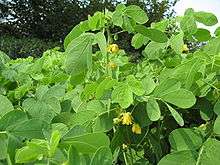Cassia gum
The term cassia gum refers to the flour made from the endosperms of the seeds of Senna obtusifolia and Senna tora (also called Cassia obtusifolia or Cassia tora). It is composed of at least 75% polysaccharide, primarily galactomannan with a mannose:galactose ratio of 5:1, resulting in a high molecular mass of 200,000-300,000 Da.[1]

Approval
Japan
In 1995, cassia gum was added to the list of approved food additives in Japan by the Japanese Ministry of Health and Welfare.[2][3]
United States
Two GRAS notices were filed to the U.S. Food and Drug Administration (FDA), one on June 23, 2000 (GRN 51) and one on November 21, 2003 (GRN 139), both of which were not evaluated due to notifier's request to cease evaluation.[4] In June 2008, specialty firm Lubrizol Advanced Material filed a petition to the FDA proposing that food regulations be amended to provide for the use of cassia gum as a stabilizer in frozen dairy desserts. Approval in the US is still pending, with no clear indication of when it may be obtained.[5]
European Union
In 2010, cassia gum received EU approval for human food applications.[6]
Uses
It is used as a thickener and gelling agent,[7] and has E-number E427 in food[8] and E499 in feed (pet food).[9]
References
- Joint FAO/WHO Expert Committee on Food Additives. Meeting (2010). Safety Evaluation of Certain Food Additives. World Health Organization. pp. 11–12. ISBN 978-92-4-166062-4.
- "Opinion of the Scientific Panel on food additives, flavourings, processing aids and materials in contact with food (AFC) related to an application on the use of cassia gum as a food additive". EFSA Journal. 4 (12): 389. 2006. doi:10.2903/j.efsa.2006.389. ISSN 1831-4732.
- "List of Existing Food Additives". The Japan Food Chemical Research Foundation.
- "GRAS notices". www.fda.gov. U.S. Food and Drug Administration.
- "Petition for 'Use of cassia gum as a stabilizer in frozen dairy desserts'". www.fda.gov. U.S. Food and Drug Administration.
- "New additives approved for use". Food Standards Agency. Retrieved 26 November 2010.
- N. K. Mathur (19 April 2016). Industrial Galactomannan Polysaccharides. CRC Press. pp. 142–143. ISBN 978-1-4398-4629-2.
- "Current EU approved additives and their E Numbers". www.food.gov.uk. Food Standards Agency.
- "Register of Feed Additives" (PDF). European Commission.